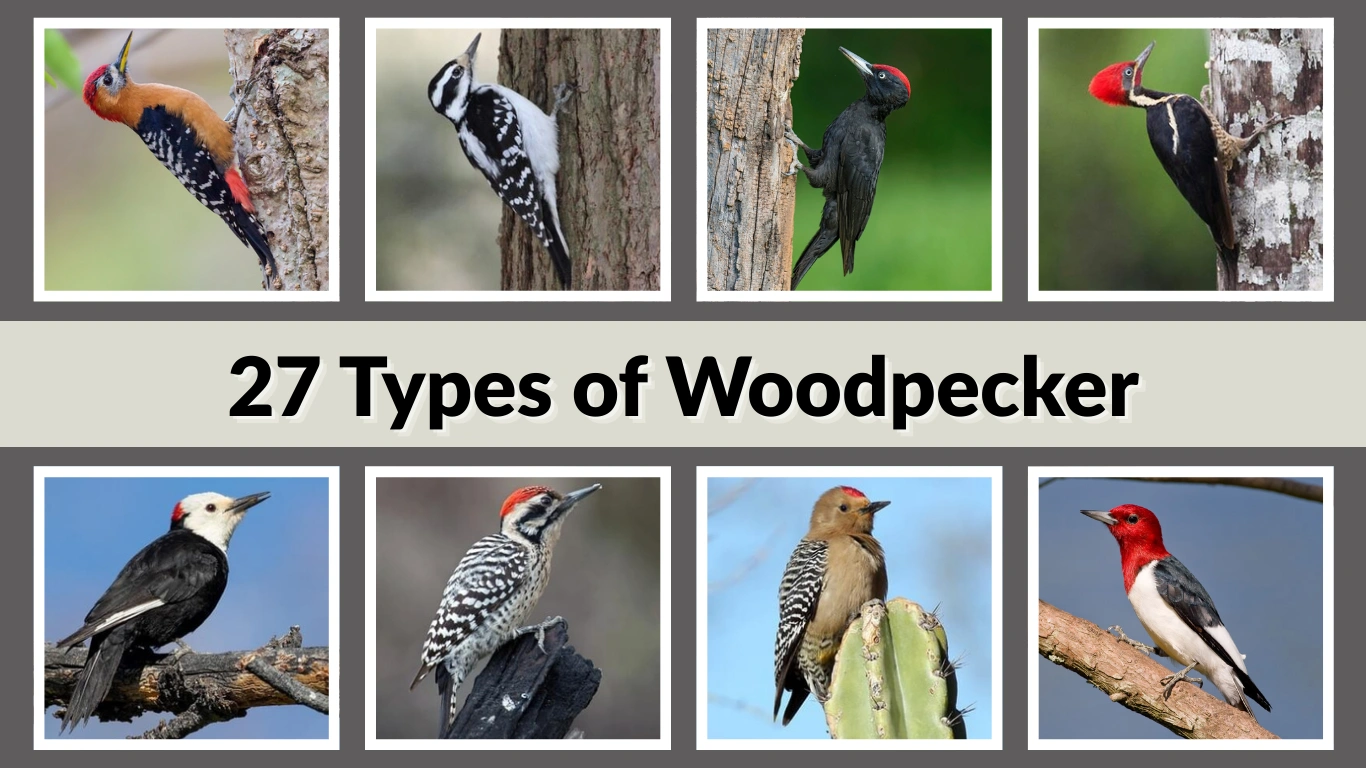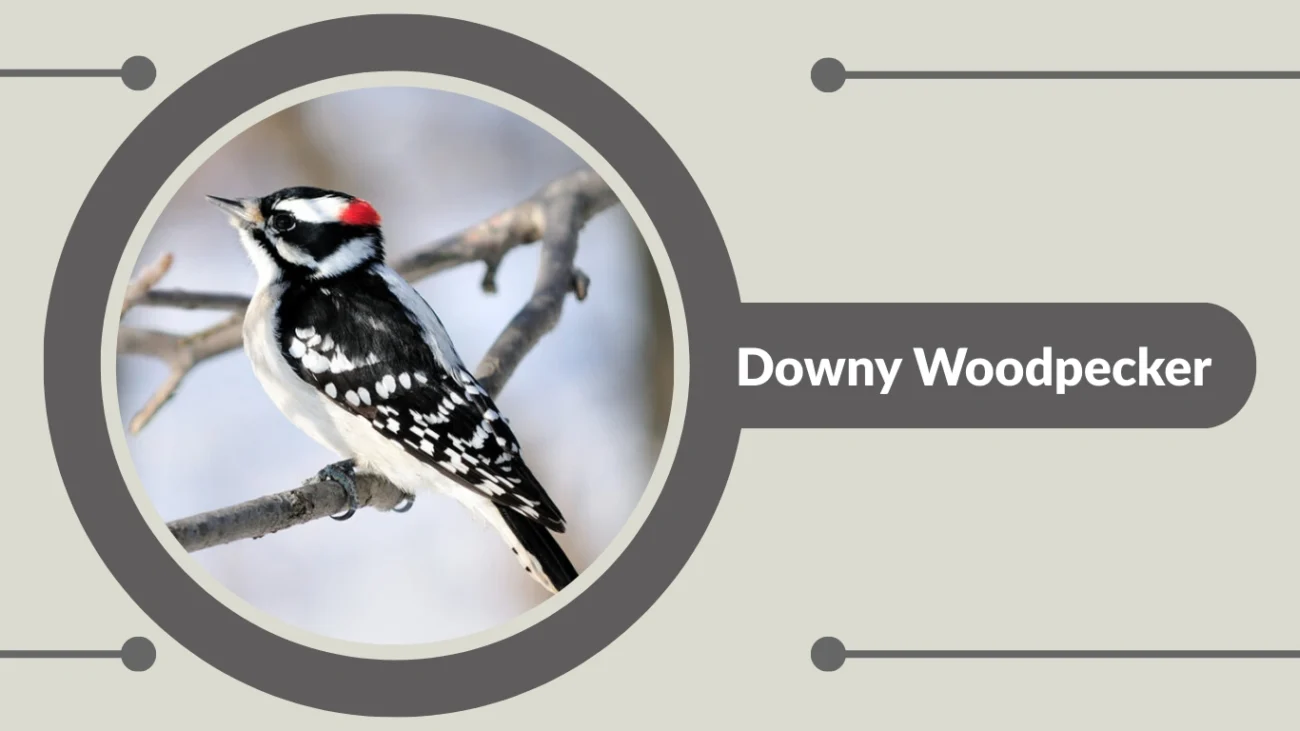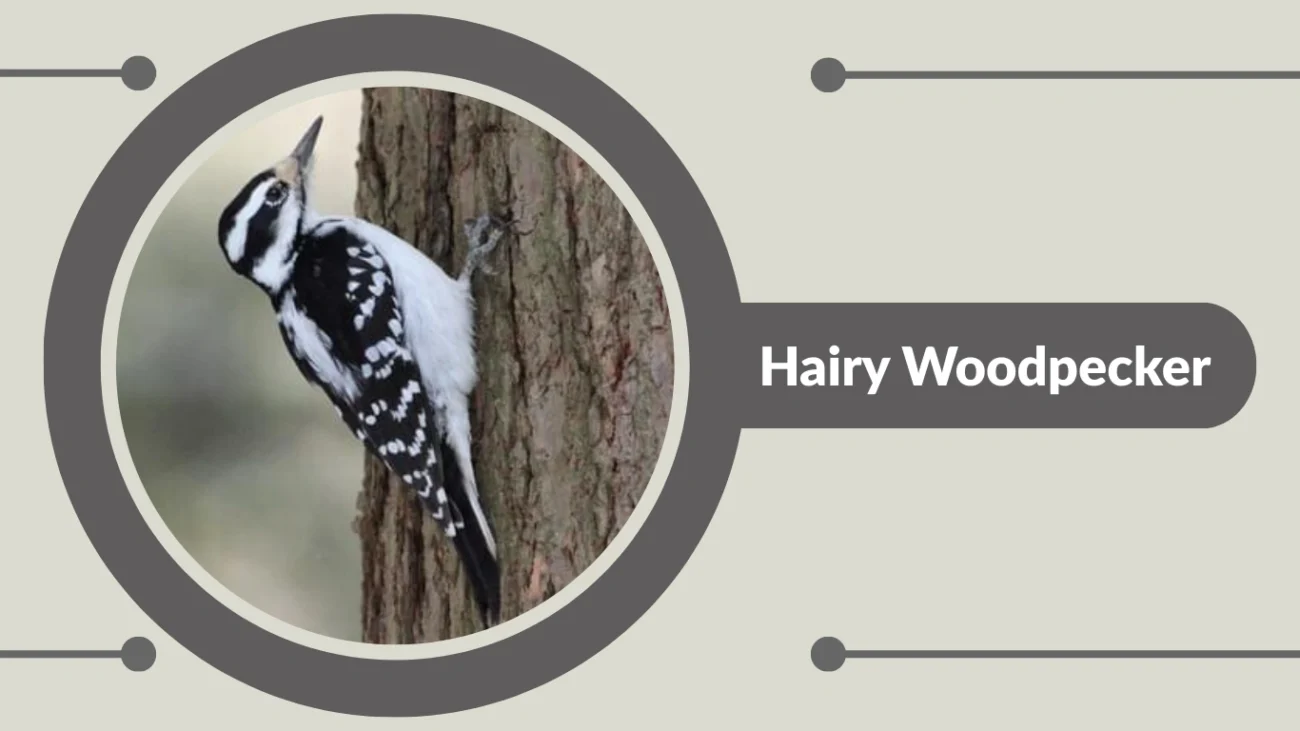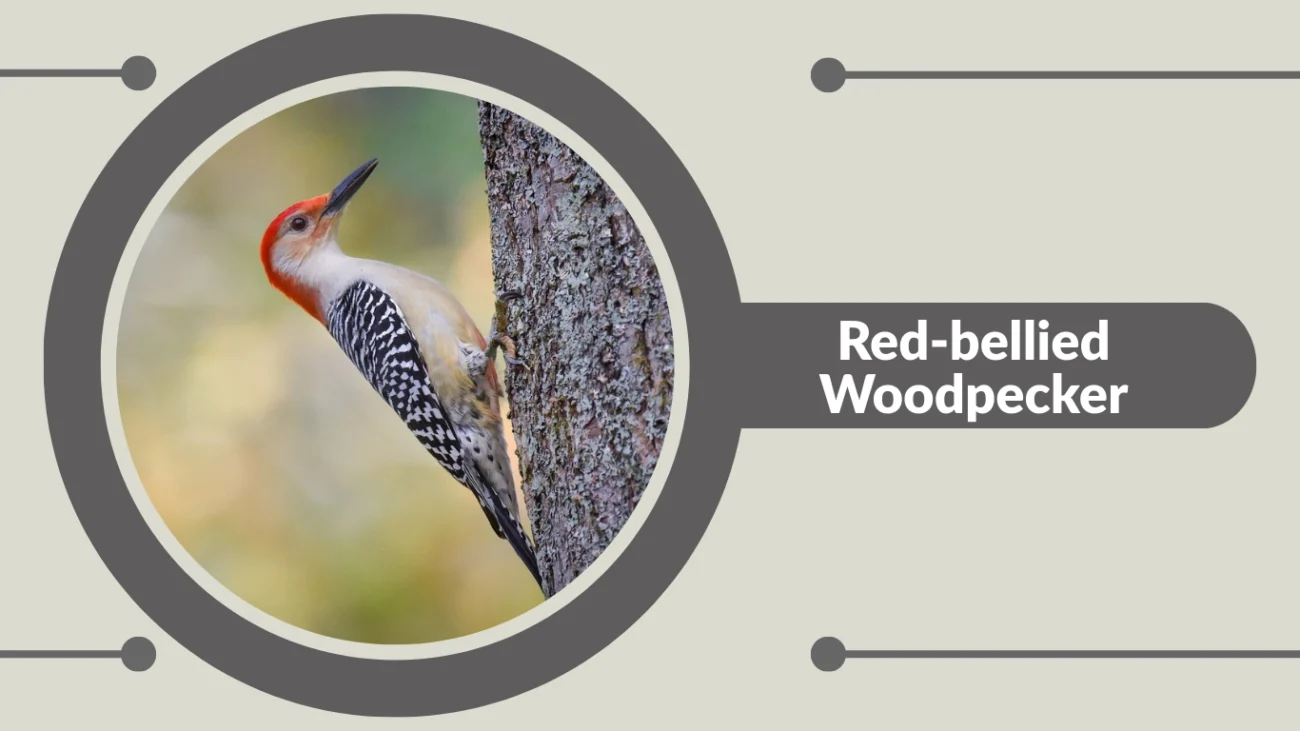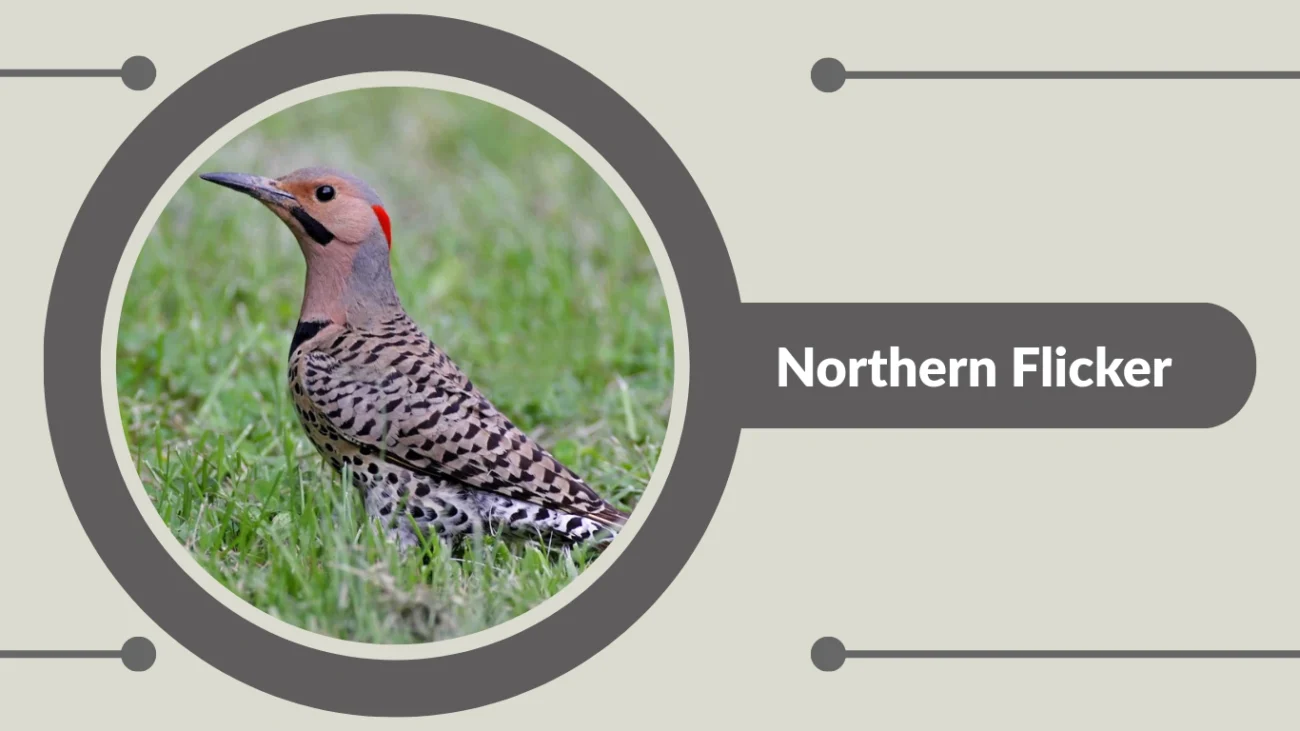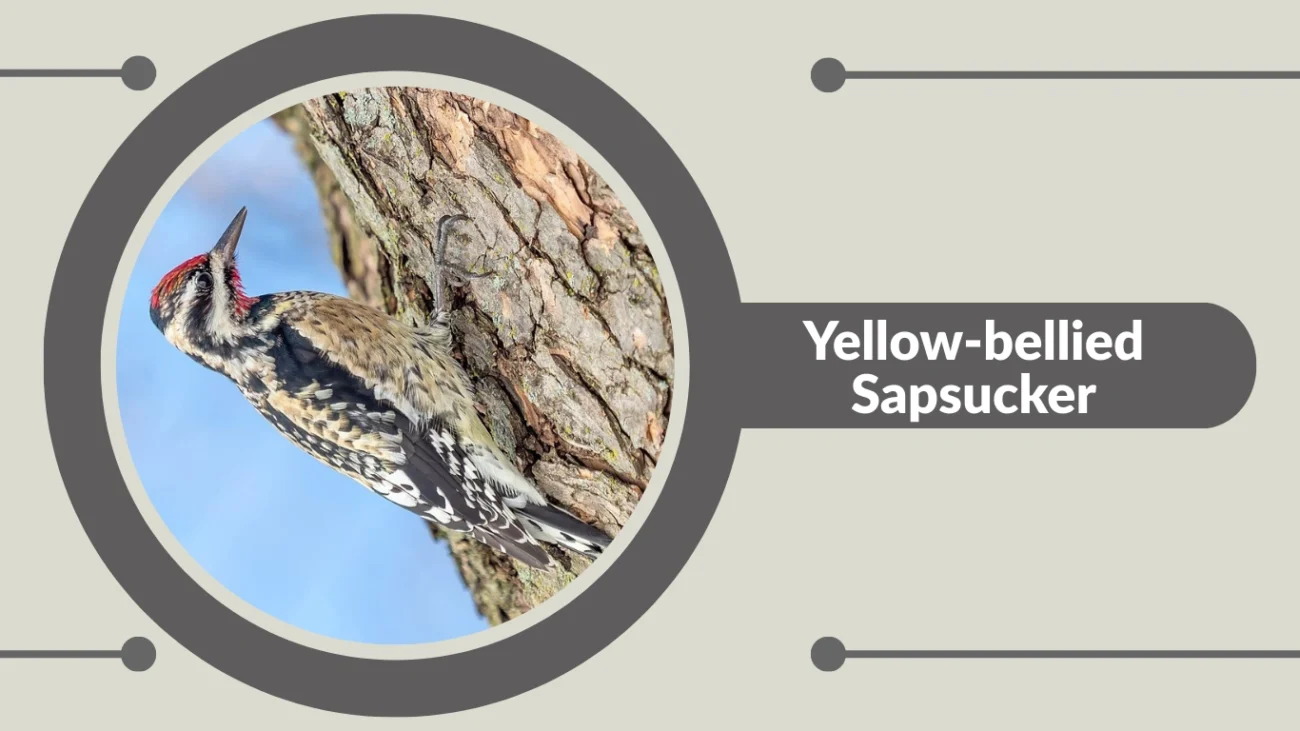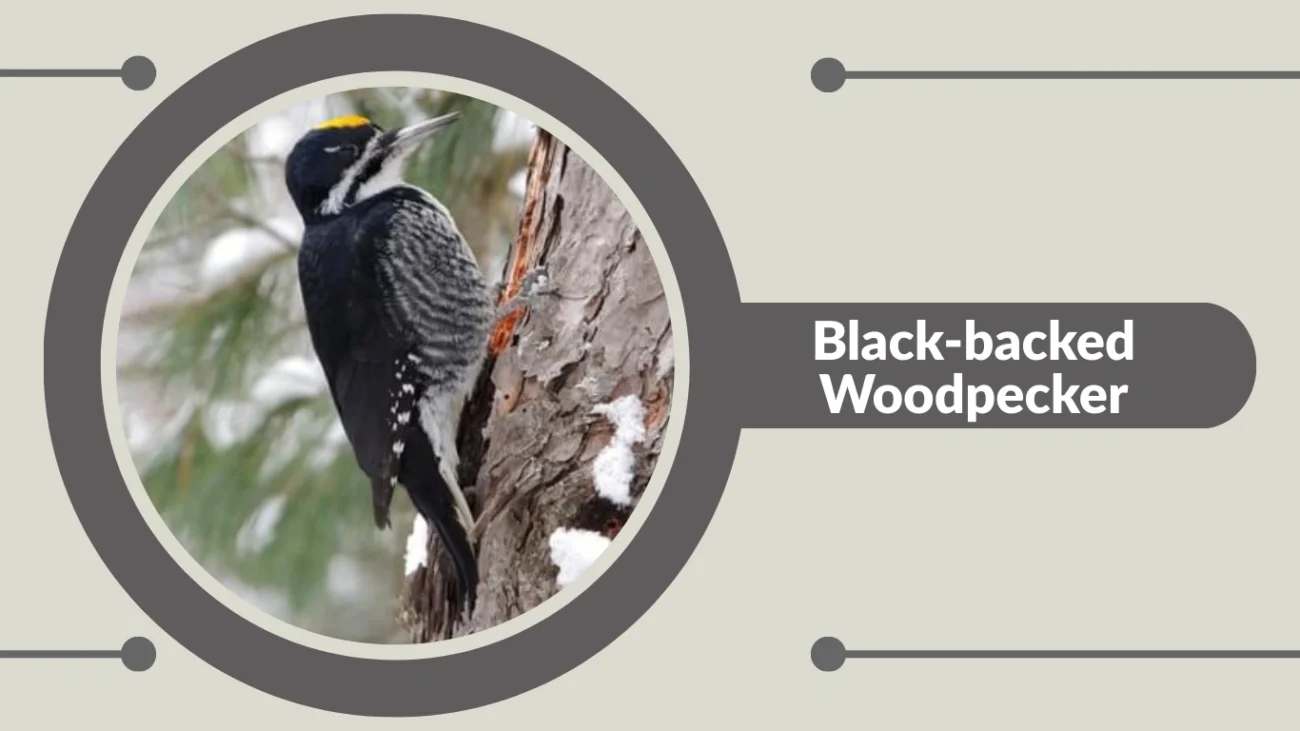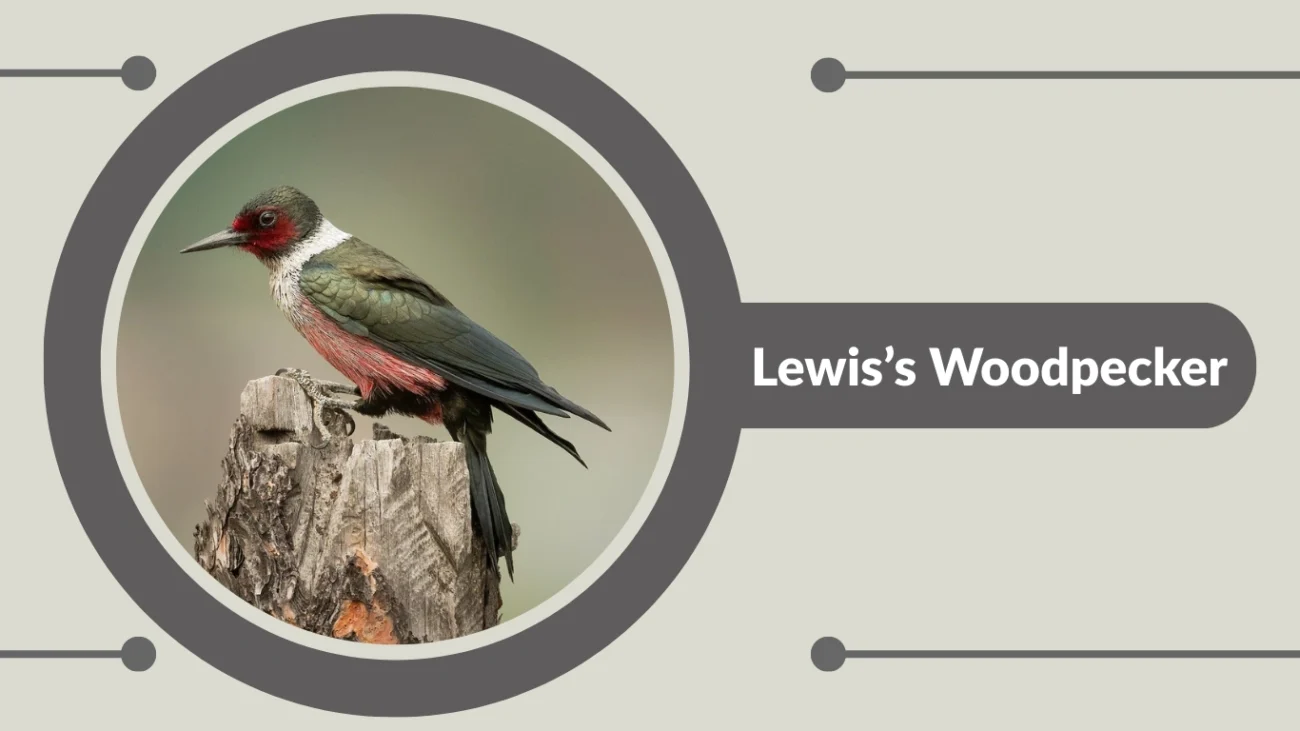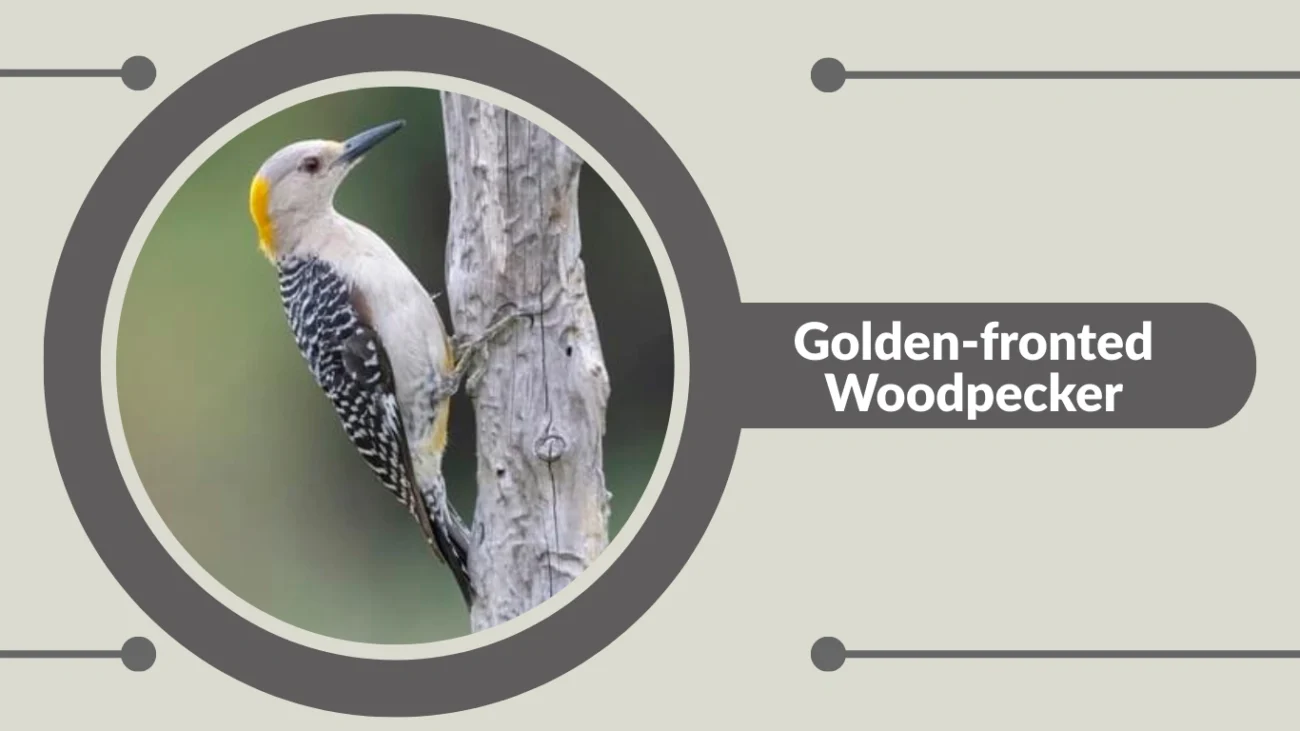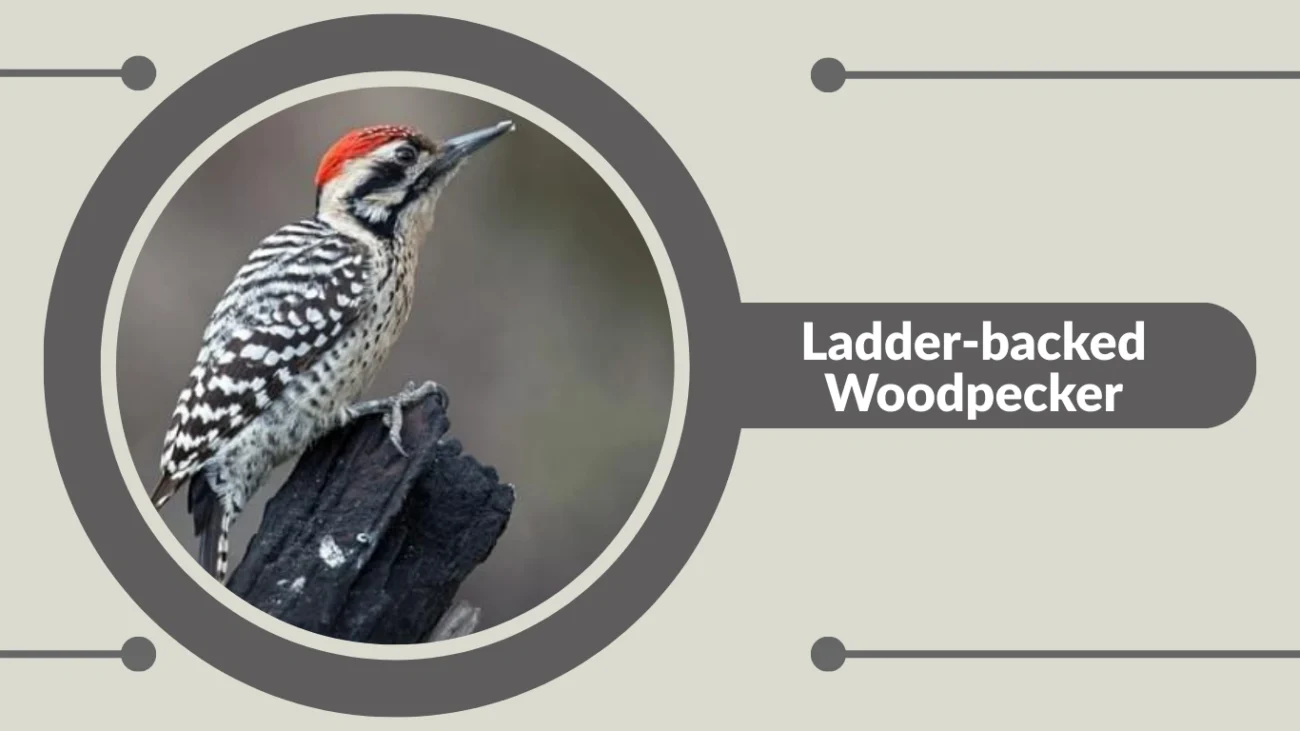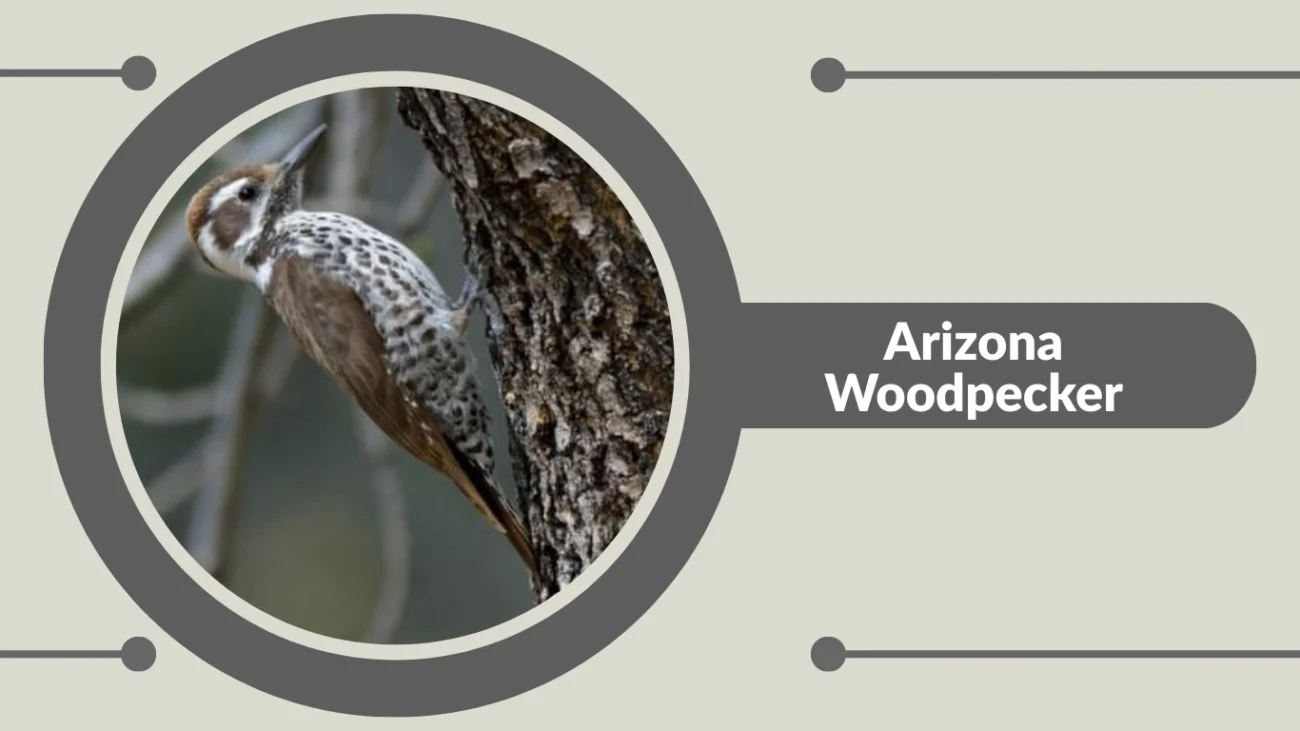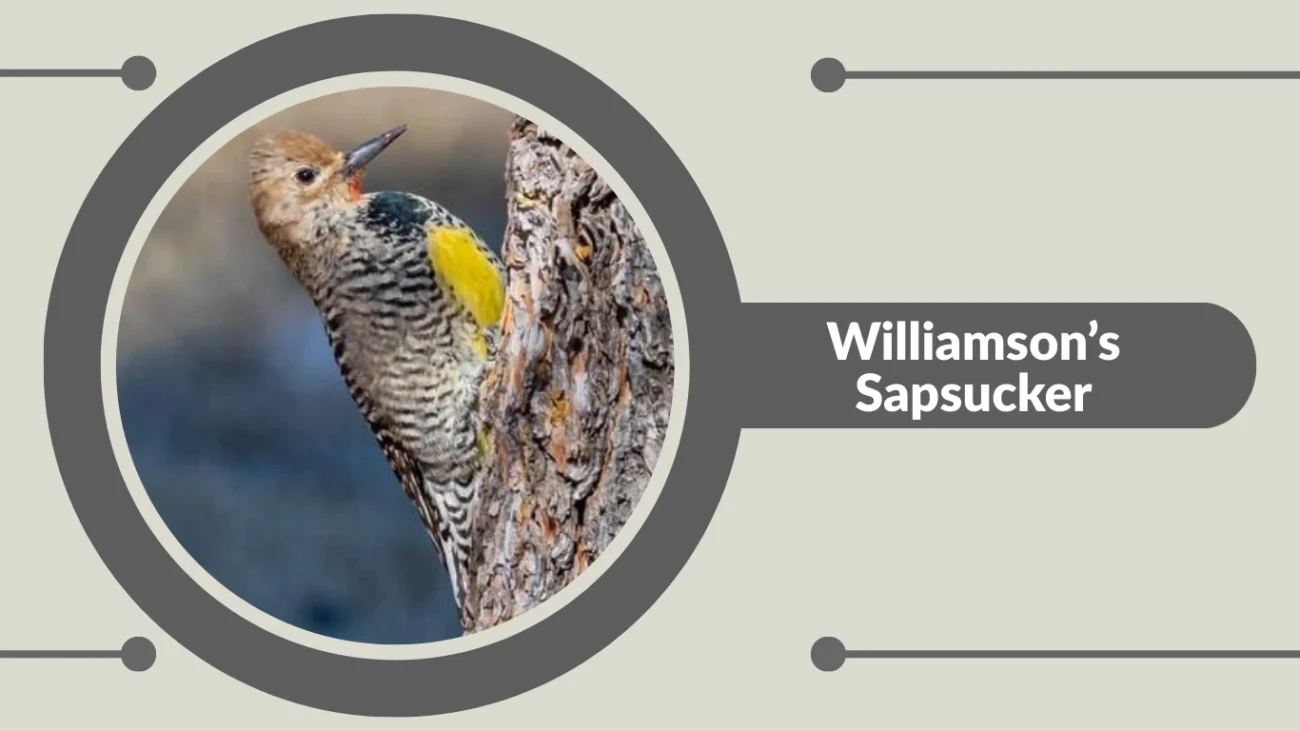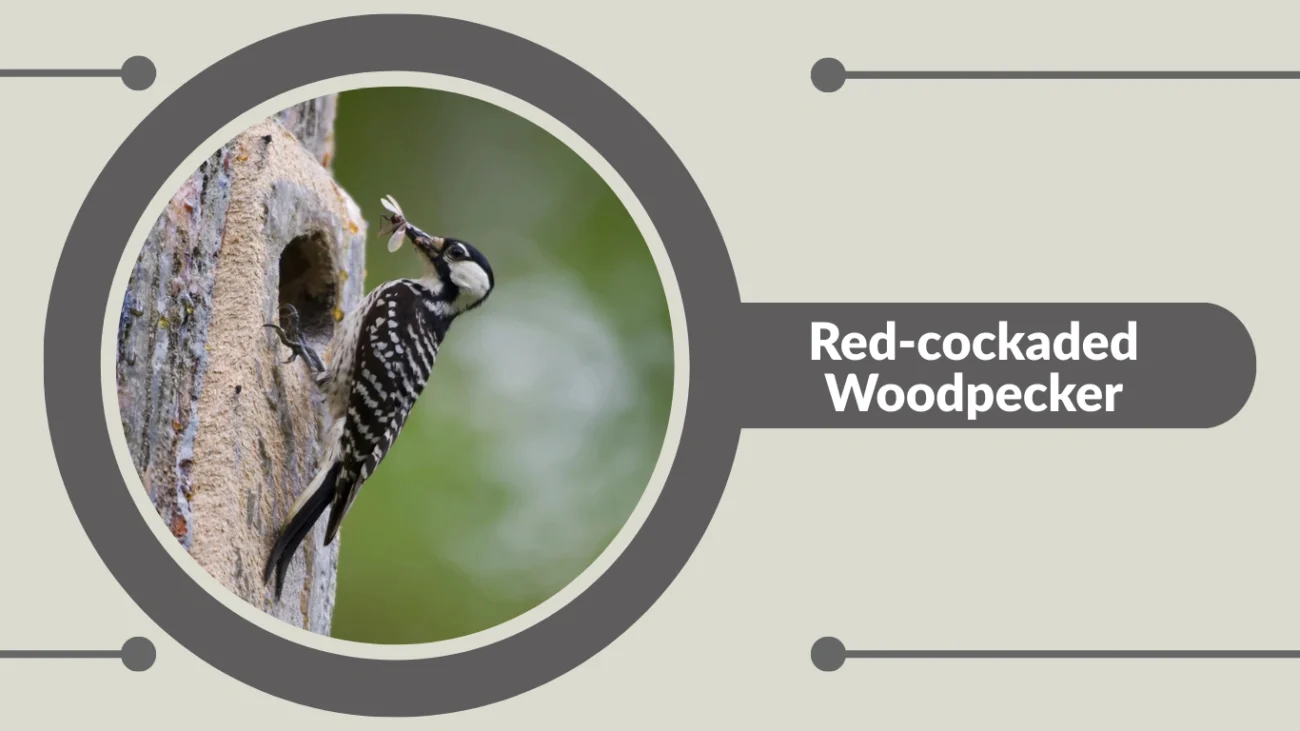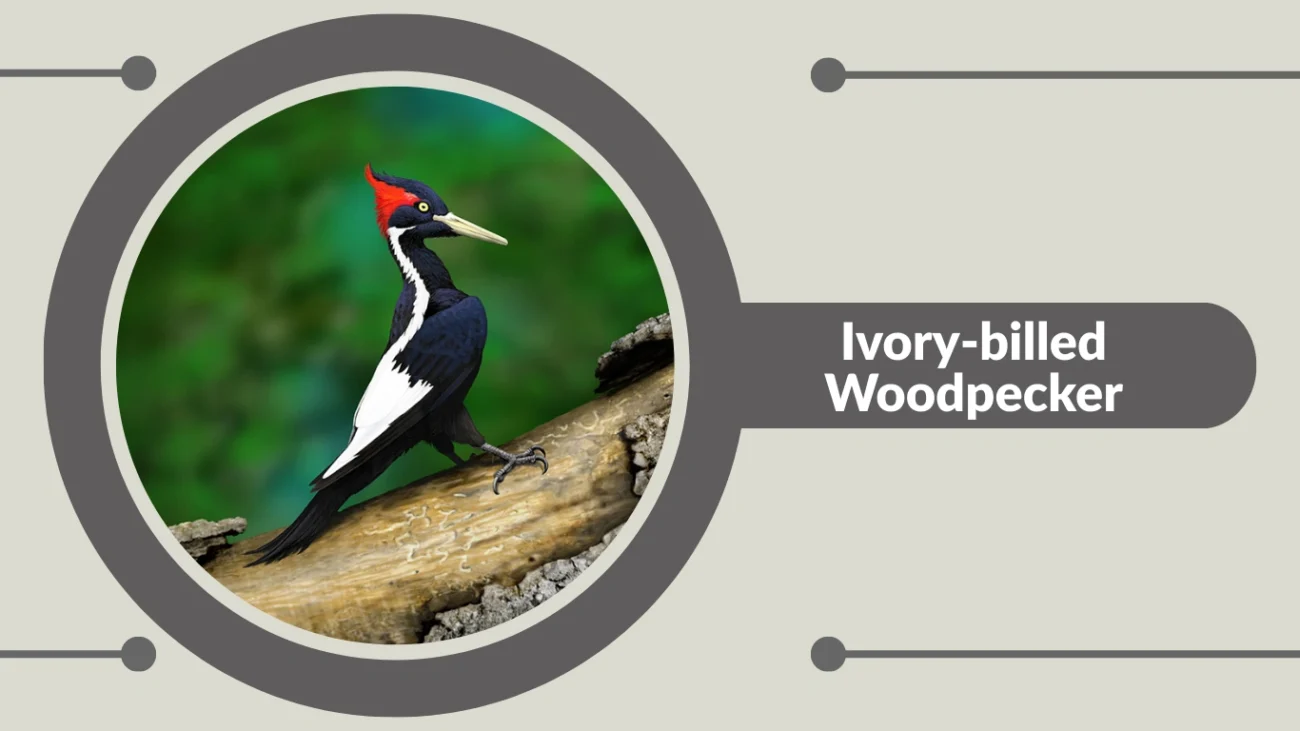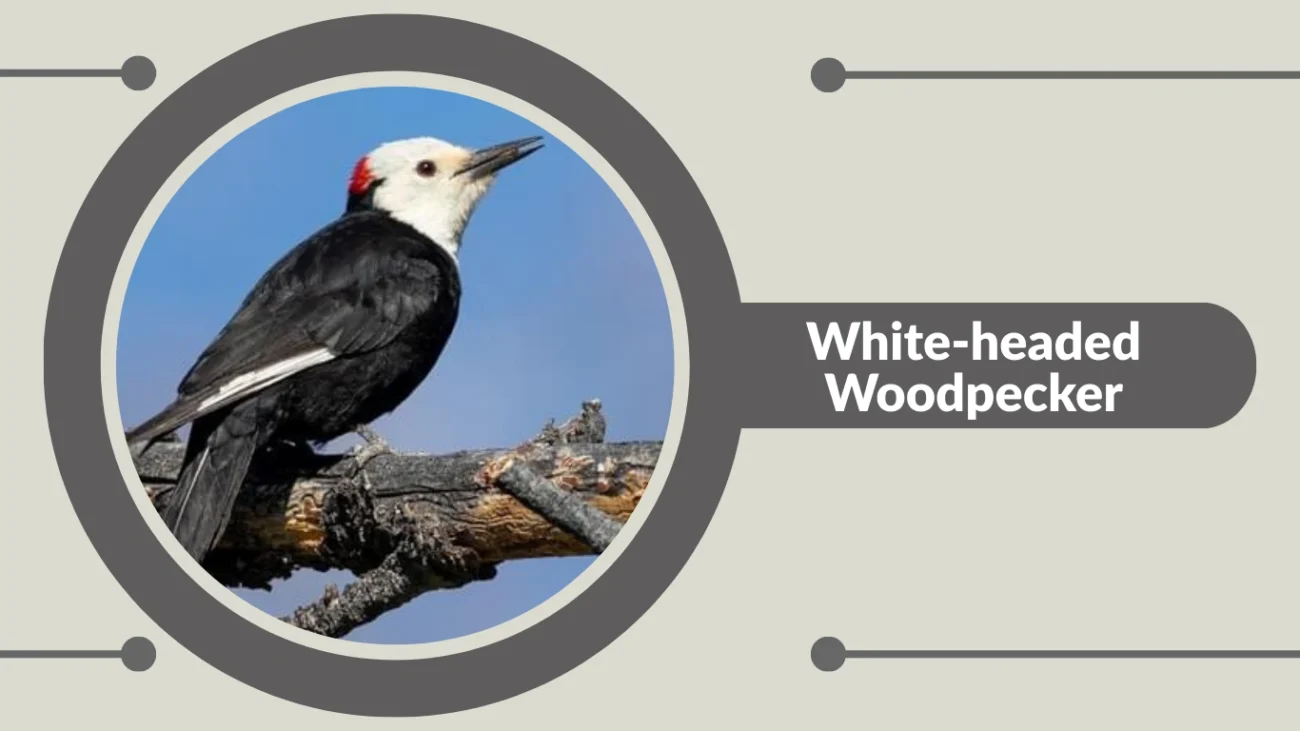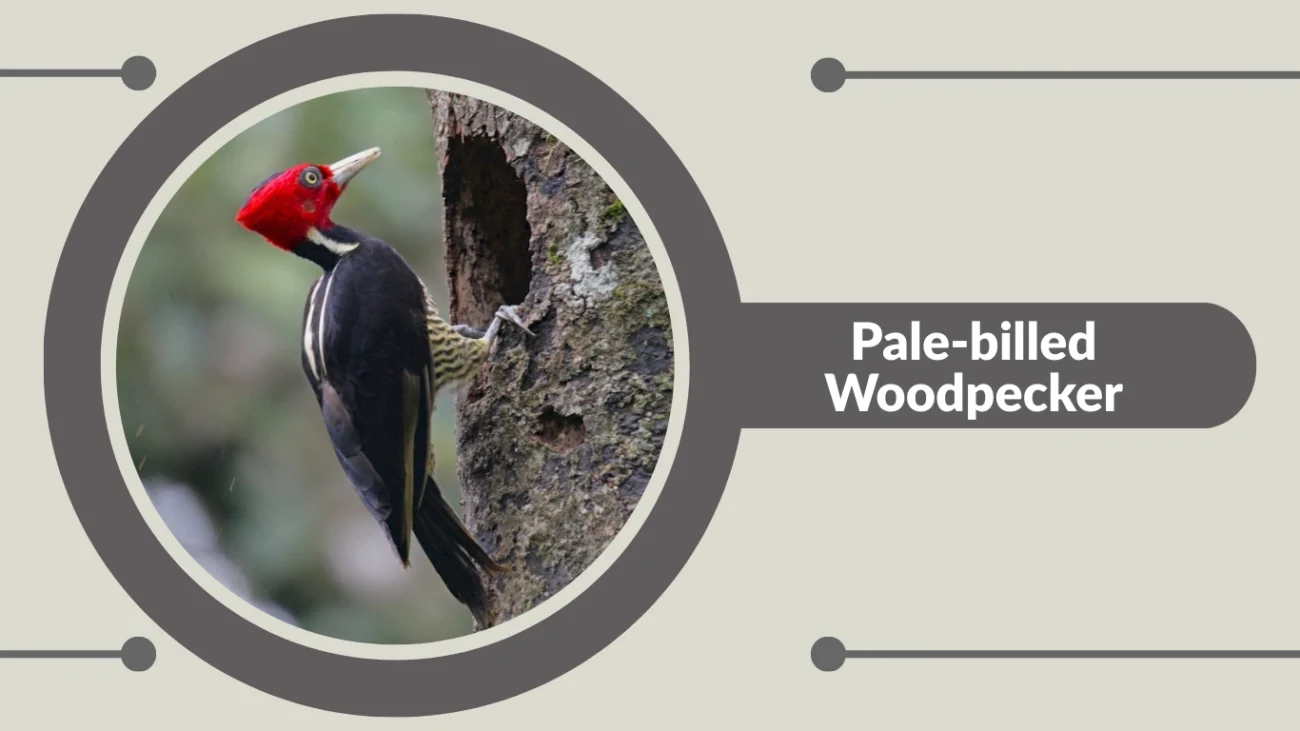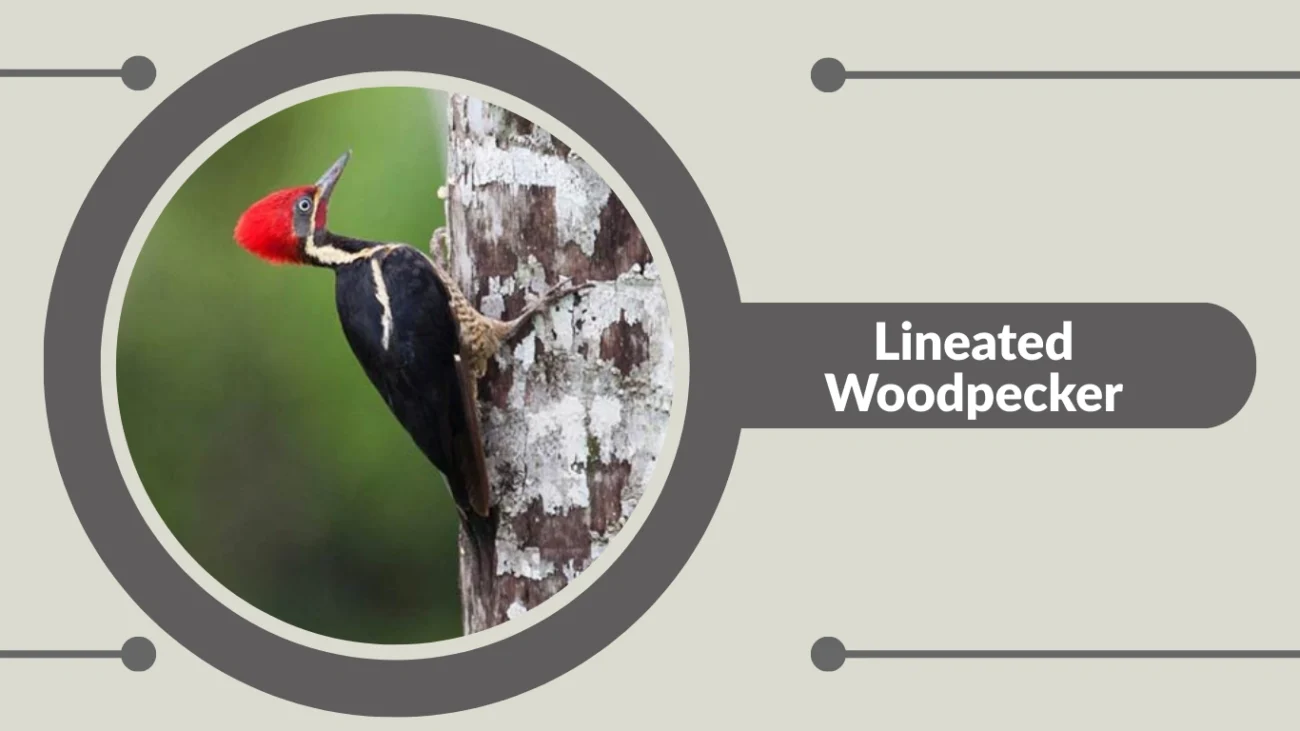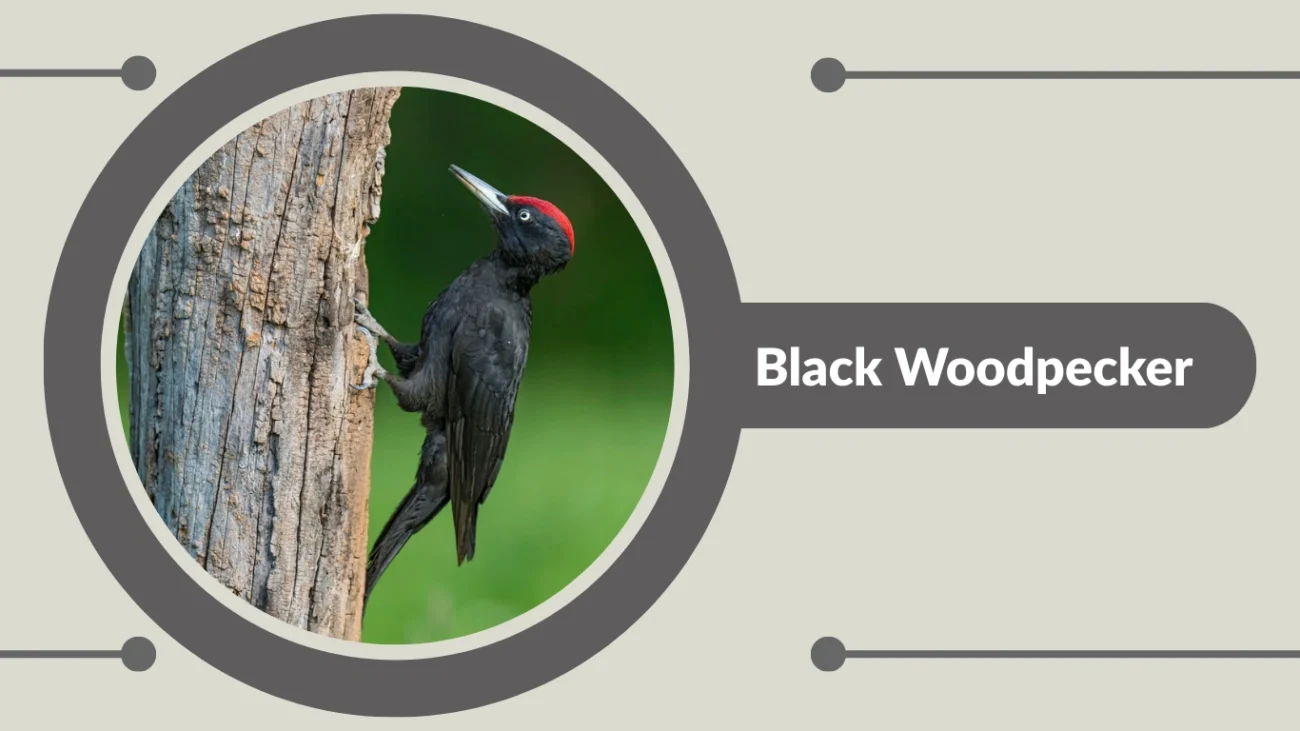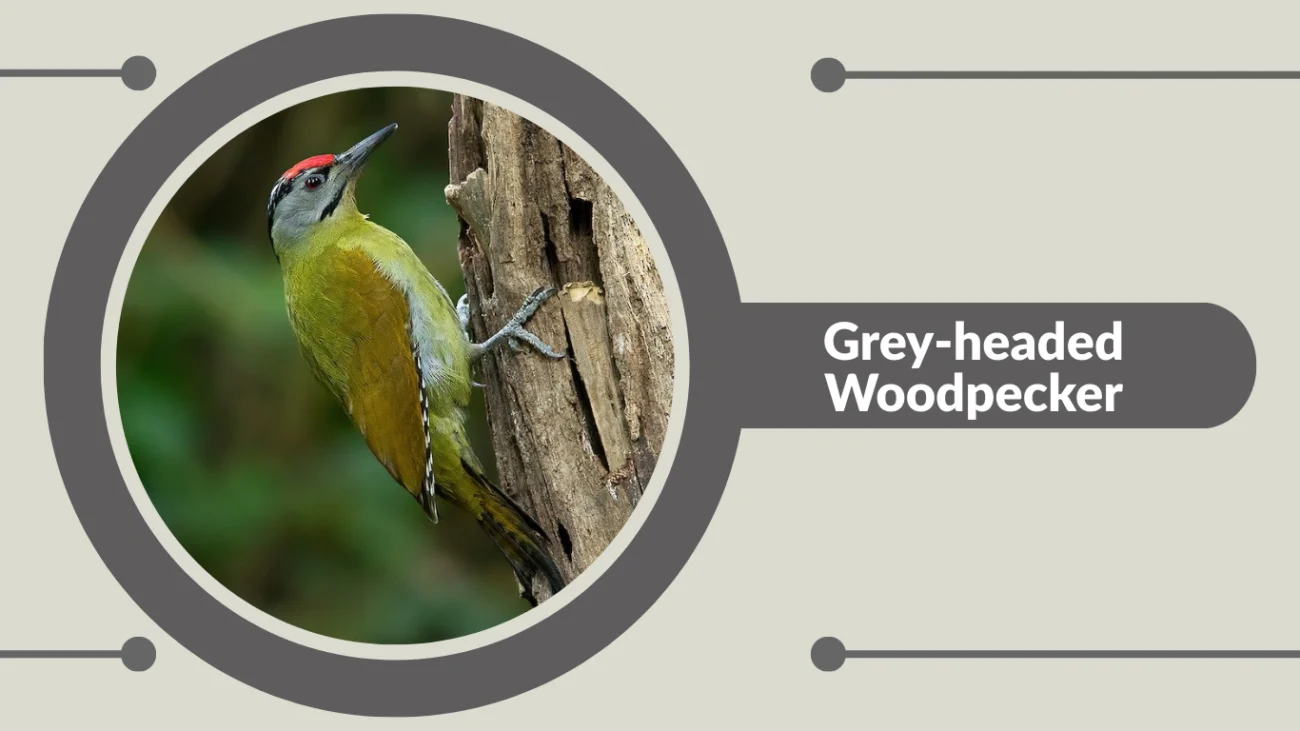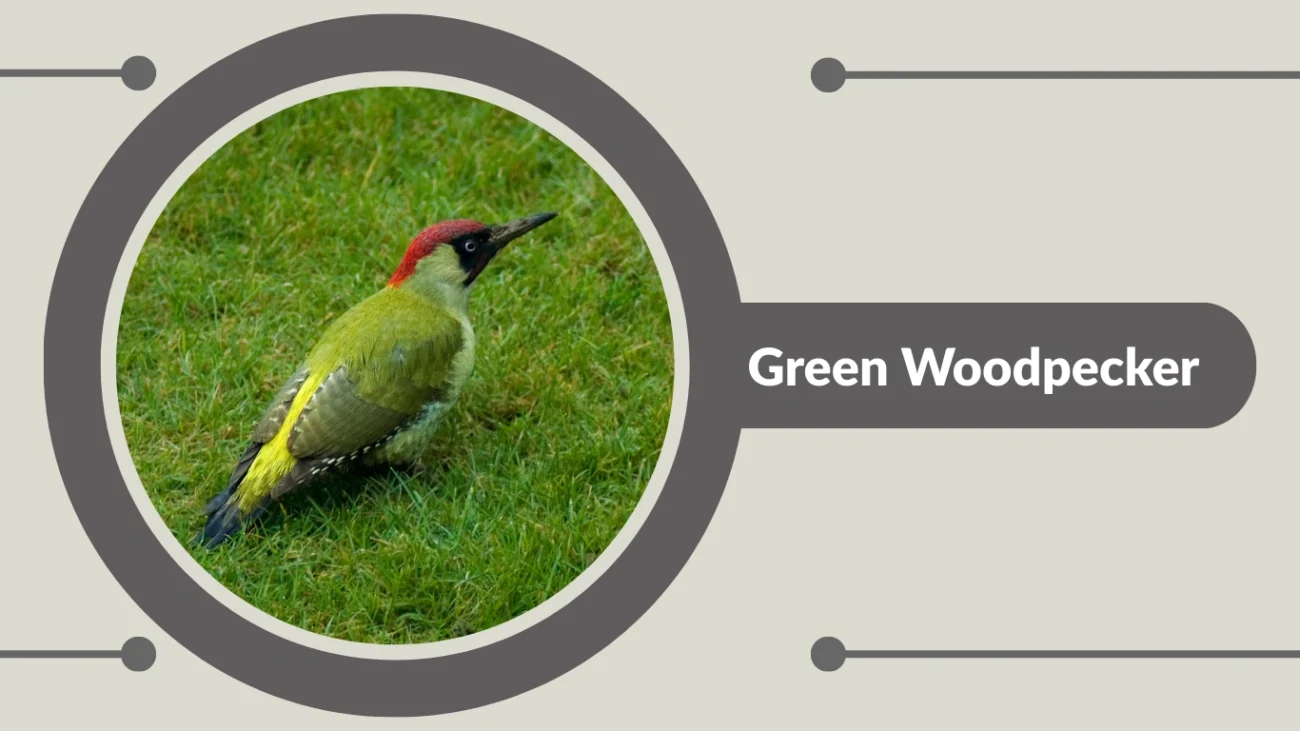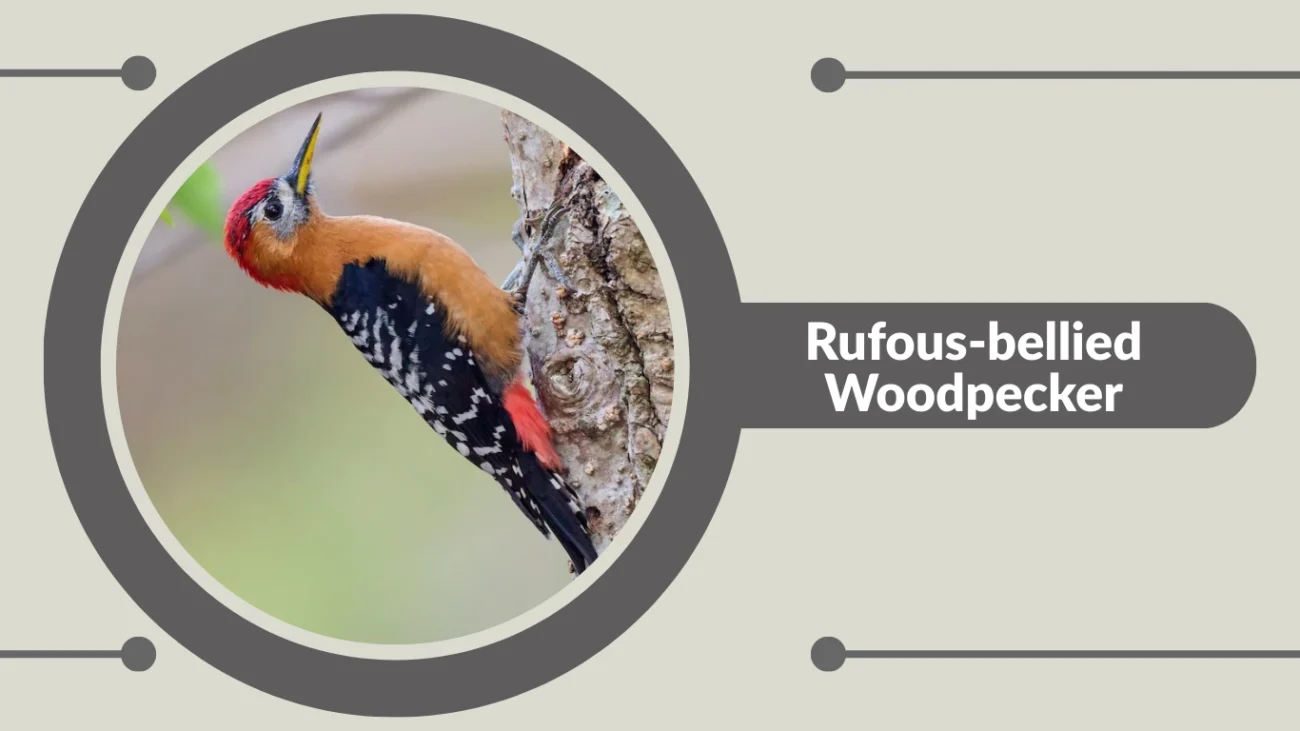Woodpeckers are among the most fascinating birds in the avian world, known for their unique ability to drum on wood, strong bills, and remarkable foraging techniques. With species spread across diverse habitats worldwide, they play an essential role in controlling insect populations and maintaining forest health. This guide covers 27 different woodpecker species, detailing their distinctive identification traits, preferred habitats, and behavioral patterns for birdwatchers and nature enthusiasts.
1. Downy Woodpecker
The Downy Woodpecker is the smallest and one of the most common woodpeckers in North America. Known for its black-and-white plumage and energetic tapping on tree trunks, it is often seen in backyards, parks, and forests. This species is friendly around feeders and plays a key role in controlling insect populations.
Identification
- Scientific Name: Dryobates pubescens
- Size: 5.5–6.7 inches (14–17 cm)
- Color: Black and white pattern with a white belly; males have a small red patch on the back of the head
- Bill: Short and chisel-shaped
- Wings: Black with white spots
- Tail: Black with white outer feathers
Habitat and Distribution
Downy Woodpeckers inhabit woodlands, orchards, parks, and suburban gardens. They are found across most of North America, from Alaska and Canada down to Florida and parts of Central America.
Behavior and Diet
They feed primarily on insects, larvae, and spiders, but also consume seeds, berries, and sap. Downy Woodpeckers often forage by pecking and probing bark, and they frequently visit suet feeders in winter.
2. Hairy Woodpecker
The Hairy Woodpecker is a medium-sized woodpecker that closely resembles the Downy Woodpecker but is noticeably larger with a longer bill. It is a widespread species across North America, thriving in forests, wooded parks, and suburban areas. Known for its loud drumming and persistent tapping, this bird is a vital insect predator in woodland ecosystems.
Identification
- Scientific Name: Dryobates villosus
- Size: 7.1–10.2 inches (18–26 cm)
- Color: Black and white plumage with a white underside; males have a red patch on the back of the head
- Bill: Long, straight, and chisel-shaped
- Wings: Black with distinctive white spots
- Tail: Stiff and black with white outer feathers
Habitat and Distribution
Hairy Woodpeckers are found in mature forests, wooded suburbs, orchards, and parks across most of the United States, Canada, and parts of Mexico. They prefer areas with large trees for nesting and foraging.
Behavior and Diet
Their diet consists mainly of insects, especially beetle larvae, ants, and caterpillars. They also feed on seeds, nuts, and berries. Hairy Woodpeckers often hammer into tree trunks to reach deep-burrowing insects and will visit backyard feeders offering suet or peanuts.
3. Pileated Woodpecker
The Pileated Woodpecker is one of the largest woodpecker species in North America, instantly recognizable by its striking red crest and loud, resonant drumming. Its size and bold markings make it an iconic forest bird, often compared to the prehistoric-looking Ivory-billed Woodpecker.
Identification
- Scientific Name: Dryocopus pileatus
- Size: 16–19 inches (40–49 cm)
- Color: Predominantly black body with white stripes on the face and neck; vivid red crest; males have a red stripe on the cheek
- Bill: Long, sturdy, and chisel-shaped
- Wings: Broad and black with white underwing patches visible in flight
- Tail: Long and stiff for bracing on tree trunks
Habitat and Distribution
These woodpeckers inhabit mature forests, both deciduous and mixed, across much of Canada, the eastern United States, and parts of the Pacific Northwest. They favor large tracts of woodland with plenty of standing dead trees for nesting and foraging.
Behavior and Diet
Pileated Woodpeckers primarily feed on carpenter ants and wood-boring beetle larvae, chiseling large rectangular holes in dead wood. They also eat fruits, nuts, and berries. Their loud, echoing calls and powerful drumming can be heard over long distances, making them easy to detect in the forest.
4. Red-bellied Woodpecker
The Red-bellied Woodpecker is a medium-sized, colorful woodpecker often seen in the eastern United States. Despite its name, the reddish tint on its belly is often faint and overshadowed by its vivid red crown and nape. Its loud, rolling calls and acrobatic movements make it a lively presence in woodlands and backyards.
Identification
- Scientific Name: Melanerpes carolinus
- Size: 9–10.5 inches (23–27 cm)
- Color: Black-and-white barred back, pale underside with a subtle reddish wash on the belly; red crown and nape (males) or red nape only (females)
- Bill: Medium-length, sturdy, and chisel-shaped
- Wings: Black with white barring
- Tail: Stiff and black with white markings
Habitat and Distribution
They thrive in deciduous forests, wooded suburbs, and parks throughout the eastern half of the United States, from southern Canada down to Florida and the Gulf Coast. They adapt well to human-altered landscapes with mature trees.
Behavior and Diet
This species feeds on insects, spiders, nuts, seeds, and fruit. It is also known to cache food in tree crevices for later use. Red-bellied Woodpeckers are skilled climbers, often moving along tree trunks and large branches in search of prey.
5. Red-headed Woodpecker
The Red-headed Woodpecker is a striking bird, instantly recognized by its bold, crimson head, snow-white body, and black wings. Known as one of the most visually distinctive woodpeckers in North America, it is both an adept forager and an agile flier, sometimes catching insects in midair.
Identification
- Scientific Name: Melanerpes erythrocephalus
- Size: 7.5–9.1 inches (19–23 cm)
- Color: Entire head and neck bright red; body pure white; wings black with large white patches
- Bill: Medium-length, straight, and chisel-shaped
- Wings: Broad with striking white panels visible in flight
- Tail: Short, black, and stiff
Habitat and Distribution
This species prefers open woodlands, forest edges, orchards, and farmlands with scattered trees. It is found across central and eastern North America, with populations shifting southward in winter.
Behavior and Diet
Red-headed Woodpeckers are opportunistic feeders, consuming insects, seeds, nuts, and fruits. They are skilled at storing food, often wedging seeds and acorns into tree bark for later use. Unlike many woodpeckers, they frequently catch insects in flight, showcasing their versatility in feeding habits.
6. Northern Flicker
The Northern Flicker is a large, ground-feeding woodpecker that stands out from most of its relatives due to its habit of foraging on the ground for ants and beetles. It is one of the most widespread woodpecker species in North America, with two main forms: the “Yellow-shafted” in the east and north, and the “Red-shafted” in the west.
Identification
- Scientific Name: Colaptes auratus
- Size: 11–14 inches (28–36 cm)
- Color: Brownish body with black bars on the back and wings; spotted underparts with a black crescent on the chest; yellow or red wing and tail shafts depending on the subspecies
- Bill: Slightly curved, medium-length
- Wings: Broad with colored shafts visible in flight
- Tail: Stiff, pointed, and tipped with color matching the wing shafts
Habitat and Distribution
Northern Flickers inhabit open woodlands, forest edges, parks, and suburban yards across most of North America. They migrate in some parts of their range, especially in the northernmost regions, moving south in winter.
Behavior and Diet
Unlike most woodpeckers, Northern Flickers often forage on the ground, using their long barbed tongues to capture ants, beetles, and other insects. They also eat seeds, berries, and fruits. Their loud calls and distinctive drumming are common sounds in open woodland areas.
7. Yellow-bellied Sapsucker
The Yellow-bellied Sapsucker is a migratory woodpecker known for drilling neat rows of small holes in tree bark to feed on sap and the insects attracted to it. These feeding wells are used repeatedly and can sometimes be found in long horizontal lines across the trunk.
Identification
- Scientific Name: Sphyrapicus varius
- Size: 7.1–8.7 inches (18–22 cm)
- Color: Black-and-white patterned body with a pale yellowish belly; red forehead and crown in males (females have only a red forehead)
- Bill: Medium-length and straight
- Wings: Black with white wing patch
- Tail: Stiff and black with white markings
Habitat and Distribution
They breed in mixed and deciduous forests of Canada, the northeastern United States, and parts of the Appalachian Mountains, then migrate to the southeastern U.S., Central America, and the Caribbean for winter.
Behavior and Diet
Yellow-bellied Sapsuckers feed primarily on tree sap and the insects trapped in it, but they also consume fruits and berries. They are unique among woodpeckers for their systematic drilling patterns, which can be identified even without spotting the bird itself.
8. Acorn Woodpecker
The Acorn Woodpecker is a highly social woodpecker species famous for its habit of storing acorns in tree holes, fence posts, and even utility poles. Its clown-like facial markings and noisy, chattering calls make it easy to identify in its range.
Identification
- Scientific Name: Melanerpes formicivorus
- Size: 7.5–9.1 inches (19–23 cm)
- Color: Black back, white forehead, white underparts with black streaking, red crown, and distinctive white patches on the wings
- Bill: Medium-length, straight, and strong
- Wings: Black with prominent white patches visible in flight
- Tail: Black, stiff, and pointed
Habitat and Distribution
They inhabit oak woodlands, mixed forests, and areas with abundant acorn-bearing trees. Their range extends from the western United States through Mexico and into Central America, especially in regions with mild climates.
Behavior and Diet
Acorn Woodpeckers feed on insects, fruits, and nuts but are best known for collecting thousands of acorns and storing them in “granaries.” These storage trees are often communal, with multiple birds contributing and defending them. They live in cooperative family groups that share nesting and feeding duties.
9. Black-backed Woodpecker
The Black-backed Woodpecker is a medium-sized woodpecker adapted to life in recently burned forests, where it feeds primarily on wood-boring beetle larvae. Its black plumage provides camouflage against charred tree bark, making it a specialist in post-fire habitats.
Identification
- Scientific Name: Picoides arcticus
- Size: 9.1 inches (23 cm)
- Color: Glossy black back and head, white underparts, and a distinctive white stripe along the face; males have a small yellow crown patch
- Bill: Medium-length, straight, and sturdy
- Wings: Black with white spots
- Tail: Black, stiff, and pointed
Habitat and Distribution
They are primarily found in boreal and montane coniferous forests across Canada, Alaska, and the northern United States. They are most often spotted in areas affected by wildfires, where they thrive on insect-rich dead wood.
Behavior and Diet
This species specializes in peeling bark from burned trees to feed on beetle larvae. They are non-migratory and remain in their preferred habitat year-round. Black-backed Woodpeckers also consume other wood-boring insects and occasionally fruits. Their strong bills and keen hearing make them highly efficient foragers in dead and decaying trees.
10. American Three-toed Woodpecker
The American Three-toed Woodpecker is a specialized northern forest species adapted to boreal environments. Unlike most woodpeckers, it has only three toes instead of four, a trait that helps it cling firmly to vertical tree trunks while foraging.
Identification
- Scientific Name: Picoides dorsalis
- Size: 8.3–9.1 inches (21–23 cm)
- Color: Black-and-white patterned plumage with barred flanks; males have a yellow crown patch; back mostly black with narrow white barring
- Bill: Medium-length, straight, and strong
- Wings: Black with white barring
- Tail: Black and stiff for trunk support
Habitat and Distribution
They are found across Alaska, Canada, and parts of the northern United States, especially in coniferous forests. This species favors areas with dead or dying trees, particularly in forests recently affected by fire, insect outbreaks, or disease.
Behavior and Diet
American Three-toed Woodpeckers feed mostly on bark beetle larvae, wood-boring insects, and their larvae, often peeling away bark to reach hidden prey. They are quiet and methodical foragers, relying on both sight and sound to locate insects within wood. Their strong bills allow them to excavate deeply into dead trees for food.
11. Lewis’s Woodpecker
Lewis’s Woodpecker is a unique woodpecker species that behaves quite differently from most of its relatives. Instead of constant pecking, it often catches insects in midair, much like a flycatcher. Its dark, iridescent plumage and leisurely flight style make it stand out in its range.
Identification
- Scientific Name: Melanerpes lewis
- Size: 10–11 inches (25–28 cm)
- Color: Dark greenish-black back and wings, pinkish belly, gray collar, and red face
- Bill: Medium-length, straight, and sturdy
- Wings: Broad and rounded, adapted for gliding
- Tail: Black, stiff, and pointed
Habitat and Distribution
They inhabit open pine forests, burned woodlands, and areas with scattered trees, often in the western United States and parts of southern Canada. They prefer habitats with open airspace for catching flying insects.
Behavior and Diet
Unlike most woodpeckers, Lewis’s Woodpecker often hunts insects in flight, perches conspicuously, and spends less time drilling into wood. Its diet includes flying insects, berries, nuts, and seeds, and it sometimes stores acorns for winter. This species is known for its graceful, crow-like flight and social nature, often gathering in loose flocks outside the breeding season.
12. Gila Woodpecker
The Gila Woodpecker is a desert-dwelling woodpecker well adapted to the hot, arid landscapes of the American Southwest and northern Mexico. It is best known for nesting in cavities it excavates in saguaro cacti, providing shelter for many other desert species after it leaves.
Identification
- Scientific Name: Melanerpes uropygialis
- Size: 8–9.4 inches (20–24 cm)
- Color: Tan head and underparts, black-and-white barred back, males have a small red crown patch
- Bill: Medium-length, straight, and strong
- Wings: Black with white barring
- Tail: Black with white markings, stiff for support
Habitat and Distribution
Gila Woodpeckers are found in desert regions, especially in areas with saguaro cacti, mesquite trees, and riparian woodlands. Their range covers southern Arizona, southeastern California, southwestern New Mexico, and parts of Mexico.
Behavior and Diet
These woodpeckers feed on insects, cactus fruit, seeds, and berries, and they occasionally visit hummingbird feeders. They excavate nesting holes in saguaro cacti, allowing the plant’s pulp to dry and harden before raising their young inside. Gila Woodpeckers are also highly vocal, with a variety of rolling calls and sharp chatter used for communication and territory defense.
13. Golden-fronted Woodpecker
The Golden-fronted Woodpecker is a vibrant, medium-sized woodpecker recognized for its golden-yellow nape and forehead. It is a common resident of the southern United States into Central America, thriving in semi-open habitats and often visiting feeders in its range.
Identification
- Scientific Name: Melanerpes aurifrons
- Size: 8.7–10.2 inches (22–26 cm)
- Color: Black-and-white barred back, pale grayish underparts, golden nape and forehead; males have a red crown patch, females lack it
- Bill: Medium-length, straight, and sturdy
- Wings: Black with white barring
- Tail: Black with white markings, stiff for bracing
Habitat and Distribution
Golden-fronted Woodpeckers are found in open woodlands, brushlands, river groves, and urban areas. Their range includes Texas, Oklahoma, parts of northern Mexico, and stretches through Central America.
Behavior and Diet
Their diet includes insects, seeds, nuts, fruits, and occasionally nectar. They are opportunistic feeders, sometimes visiting suet and fruit feeders. Like many woodpeckers, they store surplus food in bark crevices. Their loud “churr” calls and busy activity make them easy to locate in their territory.
14. Ladder-backed Woodpecker
The Ladder-backed Woodpecker is a small, desert-adapted species named for the horizontal black-and-white “ladder” pattern on its back. It is well-suited to arid environments and is often found in thorny scrub, desert woodlands, and cactus-filled landscapes.
Identification
- Scientific Name: Dryobates scalaris
- Size: 6.3–7.1 inches (16–18 cm)
- Color: Black-and-white barred back, pale buff underparts with dark spots, males have a red crown patch, females lack it
- Bill: Short to medium, straight, and pointed
- Wings: Black with white barring
- Tail: Black with white outer feathers, stiff for support
Habitat and Distribution
This species is found in the southwestern United States, Mexico, and parts of Central America, primarily in dry scrub, desert riparian zones, and open woodlands with scattered trees and cacti.
Behavior and Diet
Ladder-backed Woodpeckers feed on insects, larvae, spiders, cactus fruits, and seeds. They forage by probing into bark, cactus pads, and even dead wood. Their quick, high-pitched “peek” calls and rapid drumming are distinctive, making them easy to identify by sound in their dry, open habitats.
15. Nuttall’s Woodpecker
Nuttall’s Woodpecker is a small, active woodpecker species found almost exclusively in California’s oak woodlands. Its rapid drumming and sharp calls make it a familiar sound in its limited range, and it often forages high in tree canopies.
Identification
- Scientific Name: Dryobates nuttallii
- Size: 6.3–7.1 inches (16–18 cm)
- Color: Black-and-white barred back, pale underparts with spots or streaks, males have a red crown patch extending from the nape to the forehead, females lack it
- Bill: Short, straight, and pointed
- Wings: Black with white barring
- Tail: Black with white outer feathers
Habitat and Distribution
This species is largely restricted to California and northern Baja California, where it prefers oak woodlands, riparian areas, and mixed forests. It rarely strays far from areas with large, mature oaks.
Behavior and Diet
Nuttall’s Woodpeckers primarily feed on insects, larvae, and spiders, but they also eat acorns and berries. They forage by probing and pecking in bark crevices and sometimes hang upside down to reach hidden prey. They are non-migratory and maintain territories year-round.
16. Arizona Woodpecker
The Arizona Woodpecker is a small, brown-plumaged woodpecker that stands out from most North American woodpeckers due to its mostly brown coloring rather than black-and-white. It is primarily found in the mountainous woodlands of the southwestern United States and Mexico.
Identification
- Scientific Name: Dryobates arizonae
- Size: 7.1–7.9 inches (18–20 cm)
- Color: Chocolate-brown upperparts, white underparts with brown spots, males have a small red crown patch at the rear of the head
- Bill: Short to medium, straight, and sturdy
- Wings: Brown with white spotting
- Tail: Brown with white markings, stiff for support
Habitat and Distribution
This species inhabits pine-oak woodlands, montane forests, and canyon areas. In the U.S., it is mainly found in southeastern Arizona and southwestern New Mexico, with its range extending into the mountains of western and central Mexico.
Behavior and Diet
Arizona Woodpeckers feed primarily on insects, larvae, and spiders, foraging on trunks and large branches. They often move methodically along the bark, pecking and probing to find food. They are non-migratory and maintain territories year-round, nesting in tree cavities excavated in dead or decaying wood.
17. Williamson’s Sapsucker
Williamson’s Sapsucker is a striking woodpecker species with strong sexual dimorphism, meaning males and females look very different. As its name suggests, it specializes in drilling sap wells in trees, but it also eats insects and fruits.
Identification
- Scientific Name: Sphyrapicus thyroideus
- Size: 8.3–9.8 inches (21–25 cm)
- Color:
- Male: Black back and underparts, white wing patches, bright yellow belly, red throat, and white facial stripes
- Female: Brown-barred back and flanks, buffy underparts with brown streaks, and a yellow belly
- Male: Black back and underparts, white wing patches, bright yellow belly, red throat, and white facial stripes
- Bill: Medium-length, straight, and chisel-shaped
- Wings: Broad with white patches visible in flight
- Tail: Black and stiff with white markings
Habitat and Distribution
They inhabit coniferous and mixed forests, especially in mountainous areas. Their breeding range includes the western United States, southwestern Canada, and parts of northern Mexico. They winter farther south or in lower elevations.
Behavior and Diet
Williamson’s Sapsuckers drill neat rows of sap wells in living trees, feeding on the sap as well as the insects that are drawn to it. They also consume ants, beetles, and berries. Their presence is often revealed by the sound of their deliberate pecking and the sight of their distinctive feeding holes on tree trunks.
18. Red-cockaded Woodpecker
The Red-cockaded Woodpecker is a small, endangered species native to the pine forests of the southeastern United States. Its name comes from the tiny, nearly hidden red streak (“cockade”) on the side of the male’s head, which is often hard to see.
Identification
- Scientific Name: Dryobates borealis
- Size: 7.9–9.1 inches (20–23 cm)
- Color: Black-and-white barred back, white cheeks, black cap; males have a small, subtle red streak behind the eye
- Bill: Short to medium, straight, and sturdy
- Wings: Black with white barring
- Tail: Black with white outer feathers, stiff for climbing support
Habitat and Distribution
This species is restricted to mature longleaf pine and other southern pine forests, particularly those with open understories maintained by periodic fires. Its range spans from Virginia and the Carolinas through Florida and west to eastern Texas and Oklahoma.
Behavior and Diet
Red-cockaded Woodpeckers feed mainly on insects, including beetles, ants, and larvae, often foraging on live pine trees. They are unique among woodpeckers in excavating nesting cavities in living pines, often in clusters that form cooperative breeding groups. These birds depend heavily on fire-maintained pine ecosystems and have suffered major declines due to habitat loss and fire suppression.
19. Ivory-billed Woodpecker
The Ivory-billed Woodpecker is one of the most legendary and elusive birds in North America, long thought to be extinct or nearly so. It is the largest woodpecker species ever known in the United States, with striking black-and-white plumage and a massive ivory-colored bill.
Identification
- Scientific Name: Campephilus principalis
- Size: 18–20 inches (45–51 cm)
- Color: Glossy black body with white stripes down the neck; large white wing patches visible in flight; males have a bright red crest, females have a black crest
- Bill: Long, pale ivory-colored, and powerful
- Wings: Broad with extensive white on the trailing edges
- Tail: Long, black, and stiff for support
Habitat and Distribution
Historically, Ivory-billed Woodpeckers inhabited old-growth bottomland hardwood forests and cypress swamps of the southeastern United States and parts of Cuba. Today, confirmed sightings are extremely rare, and its existence remains debated among ornithologists.
Behavior and Diet
They fed primarily on large wood-boring beetle larvae, often stripping bark from dead or dying trees with powerful blows. They also consumed fruits, nuts, and seeds. The species required vast tracts of mature forest to survive, which contributed to its decline following widespread habitat destruction.
20. White-headed Woodpecker
The White-headed Woodpecker is a striking black-and-white bird easily recognized by its pure white head and contrasting black body. Unlike many woodpeckers, it relies heavily on conifer seeds rather than insects, making it a unique specialist in its habitat.
Identification
- Scientific Name: Dryobates albolarvatus
- Size: 8.3–9.1 inches (21–23 cm)
- Color: Solid black body with a bright white head; males have a small red crown patch, females lack it
- Bill: Medium-length, straight, and chisel-shaped
- Wings: Solid black with no barring
- Tail: Black, stiff, and pointed
Habitat and Distribution
They are found mainly in mature pine forests of the western United States and parts of British Columbia, particularly in areas dominated by ponderosa, Jeffrey, and sugar pines. Their range is closely tied to the distribution of large pine trees.
Behavior and Diet
White-headed Woodpeckers primarily feed on pine seeds, which they extract from cones, but they also consume insects—especially during the breeding season. They often forage quietly among pine branches, and their dependence on mature forests makes them sensitive to logging and habitat changes.
21. Pale-billed Woodpecker
The Pale-billed Woodpecker is a large, powerful woodpecker native to tropical forests of Central and South America. With its bold red head and loud, ringing calls, it is often compared to the legendary Ivory-billed Woodpecker due to its size and striking appearance.
Identification
- Scientific Name: Campephilus guatemalensis
- Size: 13–15 inches (33–38 cm)
- Color: Glossy black body with white wing markings; bright red head and crest in both sexes; large, pale ivory-colored bill
- Bill: Long, strong, and chisel-shaped
- Wings: Black with white patches visible in flight
- Tail: Long, black, and stiff for climbing support
Habitat and Distribution
They inhabit lowland and foothill tropical forests, mangroves, and forest edges from southern Mexico through Central America into parts of South America, including Colombia and Ecuador. They favor large, mature trees for nesting and foraging.
Behavior and Diet
Pale-billed Woodpeckers feed on large wood-boring beetle larvae, ants, and termites, often stripping bark from trees with powerful blows. They are also known to eat fruits and seeds. Their loud double-rap drumming and clear calls can be heard from a considerable distance, making them easier to detect than to see in dense forest canopies.
22. Lineated Woodpecker
The Lineated Woodpecker is a large, striking species often mistaken for the Ivory-billed Woodpecker due to its size and bold markings. Its loud calls and strong drumming echo through tropical and subtropical forests, making it one of the more conspicuous woodpeckers in its range.
Identification
- Scientific Name: Dryocopus lineatus
- Size: 12–14 inches (31–36 cm)
- Color: Black body with bold white facial stripes and a white patch on the wings; both sexes have a prominent red crest, males also have a red malar stripe
- Bill: Long, strong, and chisel-shaped
- Wings: Black with visible white markings in flight
- Tail: Long, black, and stiff for climbing
Habitat and Distribution
Lineated Woodpeckers inhabit tropical and subtropical forests, woodland edges, plantations, and even semi-open rural areas. Their range extends from Mexico through Central America into much of South America, including the Amazon Basin.
Behavior and Diet
They feed primarily on large insects such as beetle larvae and ants, often chiseling deep holes into tree trunks to reach their prey. They also consume fruits and nuts. Pairs maintain year-round territories, and their loud “kuk-kuk-kuk” calls can carry far through the forest canopy.
23. Great Spotted Woodpecker
The Great Spotted Woodpecker is a medium-sized woodpecker found across Europe and parts of Asia. It is one of the most familiar woodpeckers in its range, known for its loud drumming and striking black, white, and red plumage.
Identification
- Scientific Name: Dendrocopos major
- Size: 8.7–9.8 inches (22–25 cm)
- Color: Black upperparts with large white shoulder patches, white underparts, red vent; males have a red patch on the back of the head, females lack it, and juveniles have a red crown
- Bill: Medium-length, straight, and chisel-shaped
- Wings: Black with white barring
- Tail: Black with white outer feathers
Habitat and Distribution
They inhabit a variety of wooded areas, from dense forests to parks and gardens. Their range extends across most of Europe, into Russia, and parts of northern Asia. They are adaptable and thrive in both deciduous and coniferous woodlands.
Behavior and Diet
Great Spotted Woodpeckers feed on insects, larvae, seeds, and nuts. They are known for wedging nuts and pine cones into tree crevices to hammer them open. During breeding season, their rapid drumming is a key territorial signal and can be heard from far away.
24. Black Woodpecker
The Black Woodpecker is the largest woodpecker species in Europe and Asia, instantly recognizable for its entirely black plumage and striking red crown. Its loud, ringing calls and deep drumming make it a prominent presence in mature forests.
Identification
- Scientific Name: Dryocopus martius
- Size: 17–20 inches (45–50 cm)
- Color: Entirely black body; males have a full red crown, females have red only on the back of the head
- Bill: Long, pale, and chisel-shaped
- Wings: Solid black with no barring or spots
- Tail: Long, stiff, and black for strong support on trunks
Habitat and Distribution
They inhabit mature coniferous and mixed forests across Europe, Russia, and parts of northern and central Asia. They prefer large, old trees for nesting and foraging, often in undisturbed woodland.
Behavior and Diet
Black Woodpeckers feed mainly on carpenter ants, wood-boring beetle larvae, and other insects found under bark or deep inside wood. They are known to excavate large oval or rectangular holes in trees, both for feeding and nesting. Their loud, far-carrying calls and powerful drumming can be heard from a considerable distance, especially during the breeding season.
25. Grey-headed Woodpecker
The Grey-headed Woodpecker is a medium-sized woodpecker found across Europe and Asia, recognized for its soft green body and distinctive grey head. It is closely related to the Green Woodpecker but can be distinguished by its different head coloration and vocal patterns.
Identification
- Scientific Name: Picus canus
- Size: 10–12 inches (25–30 cm)
- Color: Olive-green upperparts, lighter green underparts, grey head and neck; males have a small red crown patch, females lack it
- Bill: Medium-length, straight, and chisel-shaped
- Wings: Greenish with darker flight feathers
- Tail: Dark with green tones, stiff for climbing
Habitat and Distribution
They inhabit mixed and deciduous forests, forest edges, orchards, and parks across Europe and Asia, from Scandinavia to Japan. They prefer areas with scattered trees and open ground for foraging.
Behavior and Diet
Grey-headed Woodpeckers feed mainly on ants, termites, and other insects, often foraging on the ground like the Green Woodpecker. They also consume fruits and berries seasonally. Their loud, ringing calls and rapid drumming are most often heard during the breeding season in spring.
26. Green Woodpecker
The Green Woodpecker is a large, colorful woodpecker well known for its loud, laughing call and preference for feeding on the ground. Unlike many other woodpeckers, it spends much of its time probing lawns and meadows for ants rather than drumming on trees.
Identification
- Scientific Name: Picus viridis
- Size: 12–14 inches (30–36 cm)
- Color: Bright green upperparts, yellowish rump, pale underparts with green wash; males have a red crown and black moustache with a red center, females have a black moustache without red
- Bill: Medium to long, straight, and sturdy
- Wings: Green with darker flight feathers
- Tail: Dark with green tones, stiff for support
Habitat and Distribution
Found across much of Europe and parts of western Asia, Green Woodpeckers inhabit woodlands, forest edges, orchards, grasslands, and suburban areas with scattered trees. They are often seen foraging in open grassy spaces near wooded cover.
Behavior and Diet
Their diet consists mainly of ants, which they extract from the ground using their long, sticky tongue. They also eat other insects, larvae, and occasionally fruits and berries. Green Woodpeckers are more often heard than seen, with their distinctive “yaffle” call echoing across open landscapes.
27. Rufous-bellied Woodpecker
The Rufous-bellied Woodpecker is a medium-sized, colorful woodpecker native to the forests of Asia. Its rich chestnut underparts and striking patterning make it one of the more distinctive woodpecker species in its range.
Identification
- Scientific Name: Dendrocopos hyperythrus
- Size: 8.3–9.1 inches (21–23 cm)
- Color: Black upperparts with white barring, deep rufous (reddish-brown) underparts; males have a small red crown patch, females lack it
- Bill: Medium-length, straight, and strong
- Wings: Black with white barring
- Tail: Black with white outer feathers, stiff for trunk support
Habitat and Distribution
They inhabit temperate and subtropical forests, often in hilly or mountainous areas, from the Himalayas through northern Southeast Asia and into parts of China. They favor mature forests with large trees for nesting and foraging.
Behavior and Diet
Rufous-bellied Woodpeckers feed on ants, beetle larvae, and other insects, often foraging on the trunks and branches of tall trees. They are also known to consume fruits and berries. Their strong drumming and sharp calls are common sounds in their forest habitats, especially during the breeding season.

